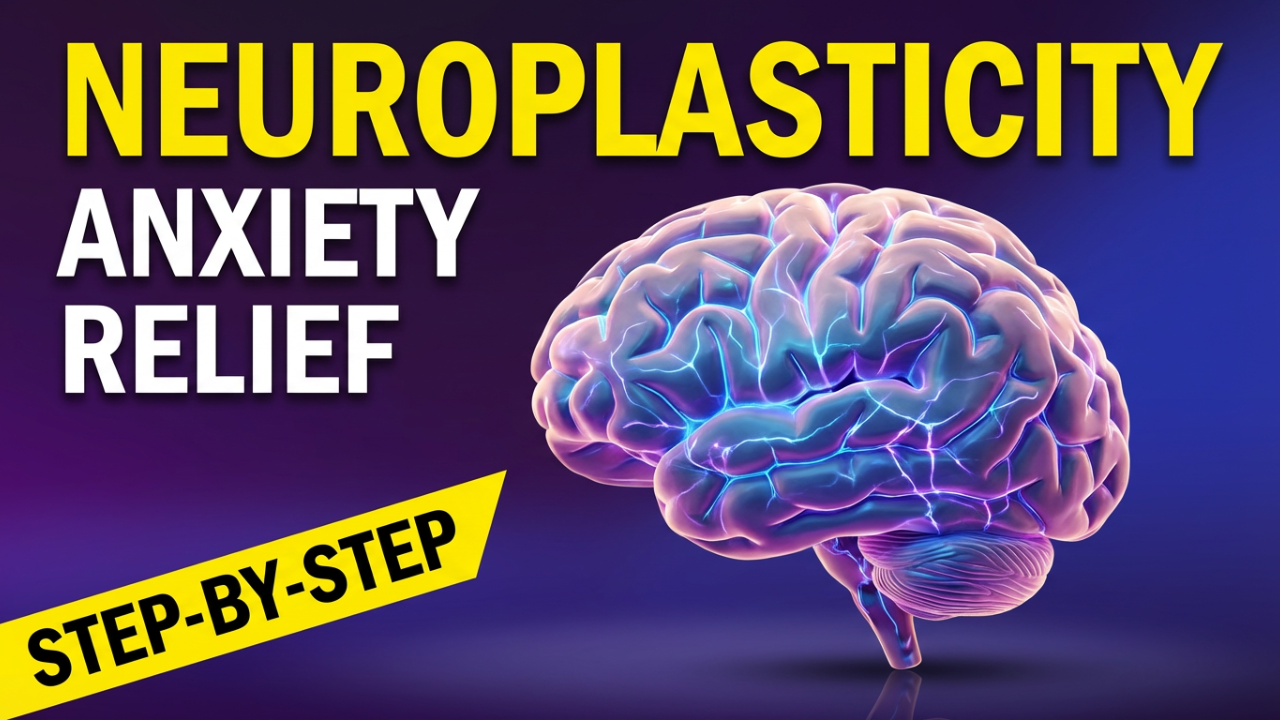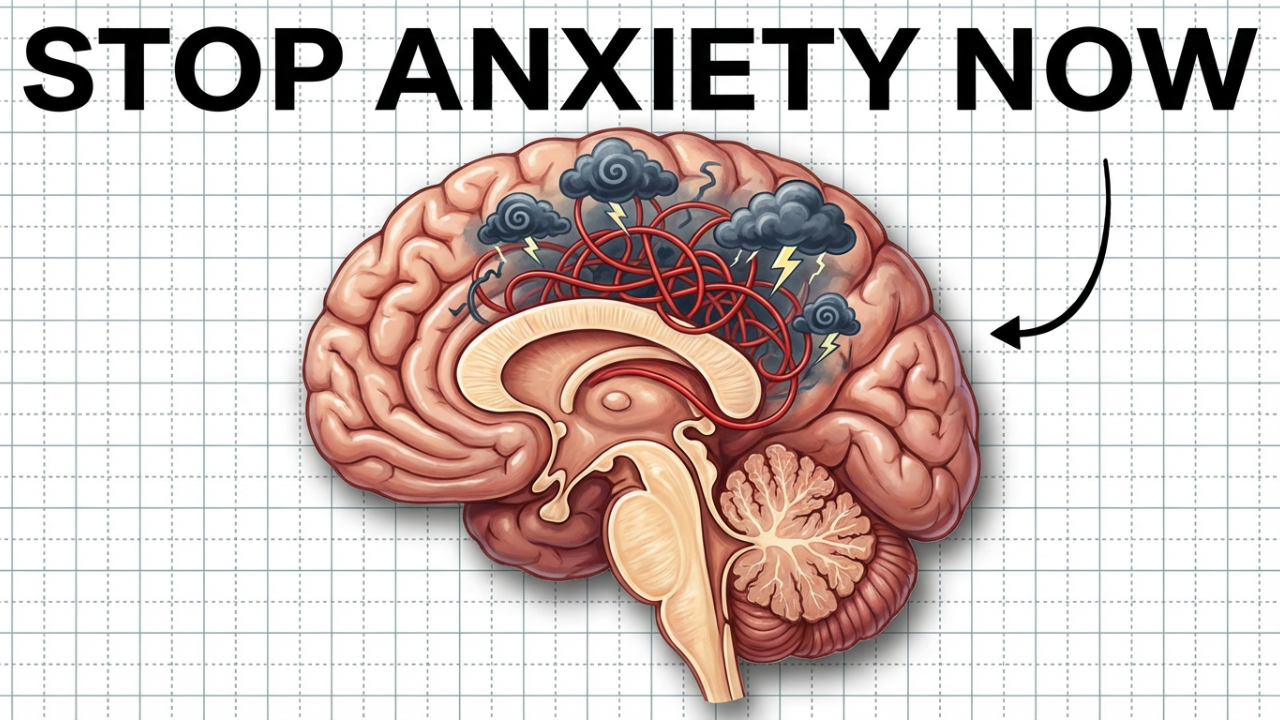It’s 3 AM. The house is silent, the world is asleep, but your brain is running a marathon. It’s replaying a conversation from yesterday, analyzing every word, every tone, every glance. It’s stress-testing a decision you have to make next week, simulating a dozen catastrophic outcomes. It’s a relentless, looping soundtrack of anxiety, worry, and what-ifs. You feel trapped in your own head, a prisoner in an endless cycle of thoughts that go nowhere but leave you exhausted, anxious, and disconnected from the present moment. Sound familiar?
This isn’t just “thinking a lot.” This is overthinking, a mental habit that can hijack your happiness and peace of mind. For years, you’ve probably been told to “just relax” or “stop worrying so much,” as if it were a switch you could simply flip. But you know it’s not that easy. It feels like quicksand; the more you struggle against the thoughts, the deeper you sink. You’ve tried meditation apps, journaling, maybe even therapy, and while they might offer temporary relief, the mental noise always finds its way back. But what if I told you that you could physically change your brain to break free from this cycle? Not with a magic pill, but with practical, daily exercises grounded in real science.
You feel trapped in these endless loops of anxiety, replaying every conversation and worrying about the future. You are not alone. This guide breaks down the science of neuroplasticity, giving you practical daily exercises to physically change your brain and finally break free. We’re not talking about wishful thinking; we’re talking about a biological process you can direct. We’re going to explore how you can become the architect of your own mind, to literally rewire the very organ that’s causing you so much distress. Stay with me, because by the end of this, you won’t just understand why you overthink; you’ll have a concrete, actionable blueprint to stop it.
This book is scientific documentary of the Kingdom of God.
Section 1: The Prison of Your Own Mind
Before we can break out of a prison, we have to understand its walls. Overthinking often falls into two buckets: rumination and worry. Rumination is compulsively replaying the past—that highlight reel of mistakes and regrets your brain loves to watch on repeat. Worry is its future-oriented cousin, the constant stream of “what if?” scenarios that always seems to predict a hurricane.
It’s important to distinguish this from productive problem-solving. Problem-solving moves forward; it seeks solutions and leads to action. Overthinking is a hamster wheel. It spins and spins, generating exhaustion but never actually going anywhere. You don’t just think about the problem; you think *about the problem* about the problem. You analyze your analysis. You worry about your worrying.
This mental vortex isn’t just emotionally draining; it has a profound physical cost. When your brain is stuck in these loops, it perceives a constant threat, keeping your body in a sustained state of fight-or-flight. Your adrenal glands pump out cortisol and adrenaline, the body’s main stress hormones. Over time, this chronic activation can lead to a cascade of health issues: a weakened immune system, digestive problems, high blood pressure, and severe fatigue. It’s linked to an increased risk for mental health conditions like anxiety and depression. Your thoughts are, quite literally, making you sick.
But why does the brain do this? The answer lies in how our brain learns and forms habits. Think of your brain as a dense forest. Every time you have a thought, you create a tiny footpath. The first time, it’s barely noticeable. But walk that same path every day, and it gets wider, clearer, and easier to travel. Now, imagine that path is a worry: “What if I get fired?” The first time you have that thought, it might be fleeting. But entertain it every day, and you’re paving a superhighway for that specific anxiety. Your brain, being efficient, will naturally default to the easiest route.
This is how overthinking becomes a habit at the neural level. The more you ruminate or worry, the stronger that neural pathway becomes. This is a form of neuroplasticity, sometimes called maladaptive plasticity, where the brain’s ability to change actually works against you. Your brain doesn’t distinguish between good or bad habits; it just strengthens the connections that are used most frequently. The cycle of negative thought carves a canyon in your brain, making it the path of least resistance. You’re not weak for falling into this trap; your brain is simply doing what it’s designed to do—optimize based on repetition.
The problem is, this optimization is working against you. The feeling of being trapped is real because, neurologically, you are. You’ve built a prison of thought, reinforced with the steel of repetition. But here’s the life-changing part: you also hold the blueprints to dismantle it.
Section 2: The Master Key – Understanding Neuroplasticity
For centuries, the belief was that the adult brain was essentially fixed. After about age 25, your brain’s structure was thought to be set in stone. If you were an anxious person, you were simply destined to be one. But over the past few decades, a revolutionary discovery has shattered this old paradigm: neuroplasticity.
Neuroplasticity is the brain’s incredible ability to reorganize itself by forming new neural connections throughout life. “Neuro” for the neurons that are our brain’s building blocks, and “plastic,” meaning malleable or changeable. Your brain is not static hardware; it’s a dynamic, living organ. This means the deeply ingrained habits of overthinking—those superhighways of anxiety—aren’t permanent. They can be rerouted. New roads can be built.
This works in a couple of ways. Structural plasticity is when your brain physically changes its structure as you learn. When you practice a new skill, like a musical instrument, you create new connections between neurons. As the saying goes, “neurons that fire together, wire together.” On the other hand, functional plasticity is the brain’s ability to shift functions from a damaged area to other, healthier areas.
Overthinking is a prime example of maladaptive plasticity. Repetitive negative thought loops strengthen certain neural pathways to the point where they become automatic. Your brain’s “fire alarm,” the amygdala, becomes hyper-vigilant, triggering a fear response based on things that haven’t even happened. But the same principle that built these pathways can be used to create new ones. This is **self-directed neuroplasticity**—the conscious and intentional rewiring of your brain through focused mental effort.
You are not merely a passenger in your own mind; you are the driver. You can consciously choose where to direct your attention. Each time you resist the pull of an anxious thought and deliberately shift your focus, you begin to forge a new neural pathway. At first, this new path is faint. It takes effort. The old highway of worry is still right there, wide and inviting.
But with consistent practice, something remarkable happens. The new, healthier pathway begins to strengthen. At the same time, the old pathway of overthinking begins to weaken from disuse through a process called synaptic pruning. Your brain, in its efficiency, reallocates resources from the abandoned highway to the new, flourishing road. You are literally building a new mind, one thought at a time.
This isn’t just a hopeful metaphor; it’s a biological reality. Studies show that practices like mindfulness can physically change the brain. For instance, consistent mindfulness can reduce the size of the amygdala, making the brain’s fear center less reactive. It’s not about fighting your brain; it’s about using your mind to guide your brain. You have the power to lay down new tracks and change the landscape of your internal world. This is the master key. Now, let’s learn how to use it.
Section 3: The Toolkit for Rewiring – Practical Daily Exercises
Understanding the science is one thing, but the real work of rewiring your brain happens in the small, consistent choices you make every day. This is your toolkit. These aren’t quick fixes but fundamental practices that, when applied with discipline, will physically reshape your brain.
**Pillar 1: Awareness – The First Step to Freedom**
You can’t change what you aren’t aware of. The first, most critical pillar is cultivating metacognitive awareness—the ability to observe your own thinking. Overthinking runs like a background app, draining your resources without you even realizing it. Awareness is opening the task manager to see exactly what’s running.
The primary tool here is **Mindfulness**. It’s the practice of paying attention to the present moment on purpose, without judgment. When a worrying thought pops up, instead of getting swept away, you simply notice it.
Here’s how to practice:
1. **Notice and Label:** The moment you catch your mind spiraling, gently label the activity. You can say to yourself, “Ah, there is worry,” or “This is rumination.” This simple act creates space between you (the observer) and the thought. Dr. Jeffrey Schwartz, a research psychiatrist at UCLA, calls this first step “Relabeling.” You identify these thoughts not as you, but as “deceptive brain messages.”
2. **Observe Like Clouds:** Imagine your thoughts are clouds passing in the sky. Some are big and dark, others are light and wispy. Your job is not to stop the clouds, but simply to watch them float by. This teaches your brain that thoughts are transient events, not permanent realities. You don’t have to engage with every thought.
3. **Anchor in the Present:** As you observe the thought, pull your mind out of the abstract past or future and anchor it in the present. What are three things you can see right now? What are two things you can hear? What does the chair feel like beneath you? This grounding practice yanks your attention back to the tangible reality of the here and now.
The goal isn’t an empty mind; it’s to change your *relationship* with your thoughts. You learn that you are the sky, not the clouds. The clouds will always pass, but they can’t harm the sky.
**Pillar 2: Active Restructuring – The 4 R’s of Cognitive Change**
Once you have awareness, you can begin actively restructuring your thought patterns. This is where we apply a powerful framework from cognitive behavioral therapy, refined by Dr. Schwartz, known as the Four Steps: Relabel, Reframe, Refocus, and Revalue.
1. **Relabel:** We’ve touched on this. You recognize the overthinking pattern for what it is—a “deceptive brain message,” not an essential truth. You might say, “This isn’t me; this is just my overthinking habit.” This step disarms the thought.
2. **Reframe:** This is where you challenge the thought and change your perspective. Ask yourself:
* “Is this thought 100% true? What’s the evidence for and against it?”
* “Am I catastrophizing or falling into black-and-white thinking?”
* “Is there a more balanced or compassionate way to look at this?”
For example, if the thought is, “I completely messed up that presentation, everyone thinks I’m an idiot,” a reframe might be: “I stumbled on one slide, but I prepared well and delivered the rest clearly. Most people are focused on the content, not my one mistake. It’s a learning experience.” This isn’t forced positivity; it’s about finding a more realistic perspective.
3. **Refocus:** This is the most critical step for self-directed neuroplasticity. After you’ve relabeled and reframed, you must deliberately shift your attention to a different, productive, or enjoyable activity for at least a few minutes. Dr. Schwartz suggests the “5-minute rule”: commit to the new activity for at least five minutes. It could be working on a task, playing an instrument, or going for a walk. During this time, you are actively choosing to engage a different neural circuit, withdrawing energy from the overthinking pathway and investing it in a new one. This is the physical act of building a new road in your brain.
4. **Revalue:** This is the long-term result. Over time, as you consistently practice the first three steps, you automatically begin to devalue the intrusive thoughts. They lose their emotional charge. You start to see them for what they are: meaningless background noise. The old highway of worry becomes overgrown from disuse, while the new pathways of calm become your brain’s new default.
**Pillar 3: The Power of Imagination and Physicality**
Your brain often can’t tell the difference between a vividly imagined experience and a real one. We can use this to our advantage.
1. **Visualization for Letting Go:** To practice emotional detachment, close your eyes and imagine each worry as an object. Place each one on a leaf floating down a stream, or put it in a balloon and watch it drift away. This isn’t about solving the worry; it’s about practicing the mental act of release, training your brain not to cling so tightly to every thought.
2. **Physical Exercise:** Regular physical activity is one of the most powerful neuroplasticity-boosters available. Aerobic exercise increases blood flow to the brain, stimulates the growth of new neurons, and releases mood-improving endorphins. Neuroscientist Dr. Wendi Suzuki explains that when you exercise, you are literally making your prefrontal cortex and hippocampus—brain areas crucial for focus and memory—bigger and stronger. A daily 30-minute walk can have a profound impact on your brain’s ability to create and strengthen healthier pathways.
3. **Embrace Novelty:** The brain thrives on new experiences. Learning a new skill—a language, an instrument, a new game—forces your brain to create new connections and remain flexible. Even small changes, like taking a different route to work, can stimulate your brain. Novelty is the enemy of rigid, repetitive thought patterns; it shakes up the system and reminds your brain that there are countless other pathways to explore.
**Pillar 4: Optimizing Your Brain’s Environment for Change**
Rewiring your brain is hard work. To succeed, you need to create the optimal biological conditions for change. Two critical factors are focused work and deep rest.
1. **Focused Work Cycles:** Stanford neuroscientist Dr. Andrew Huberman explains that the brain learns best in focused blocks of about 90 minutes. After a session of intense concentration on any of these techniques, it’s vital to take a short break. This deliberate rest allows the brain to consolidate what it has just learned, strengthening the new neural pathways.
2. **Non-Sleep Deep Rest (NSDR):** This is a concept heavily promoted by Dr. Huberman. NSDR refers to practices like yoga nidra or certain types of meditation that guide you into a state of deep relaxation while you remain conscious. These practices are incredibly effective at accelerating neuroplasticity. Performing a 20-minute NSDR protocol after a period of focused learning can significantly enhance the rate at which your brain rewires itself. It’s like pouring fertilizer on the new neural pathways you’ve just tilled. Quality sleep is also non-negotiable, as this is when the brain does most of its housekeeping and consolidates memories.
**Pillar 5: A Structured System – The Neurocycle**
For those who benefit from a more structured approach, the “Neurocycle” method developed by Dr. Caroline Leaf provides a 5-step process designed for daily practice.
1. **Gather Awareness:** Intentionally observe your emotional and physical warning signals. What are you feeling? Where do you feel it in your body?
2. **Reflect:** Ask yourself *why* you are feeling this way. Explore the root of the thought without judgment.
3. **Write:** Write down your reflections. This translates the abstract thought into a concrete form, making it easier to analyze.
4. **Recheck:** Re-examine what you’ve written. Look for the thought patterns and triggers, and actively reframe to find a new, healthier perspective.
5. **Active Reach:** This is a simple, actionable step you will take today to practice the new perspective—a small goal to reinforce the new mindset.
Dr. Leaf suggests this cycle can be done in 15-45 minutes a day and that consistent practice over 63 days is needed to build the new thought pattern into a stable, long-term habit.
Conclusion: The Marathon, Not a Sprint
We’ve journeyed from the spinning confines of the overthinking mind to the liberating science of neuroplasticity. We’ve equipped you with a toolkit—from mindfulness to the 4 R’s and the brain-boosting power of exercise and rest.
It’s essential to absorb this final point: rewiring your brain is a gradual process. It’s a marathon, not a sprint. You are undoing years of conditioned mental habits. The popular idea that it takes 21 days to form a habit is a simplification that can be misleading. Research shows the time it takes for a new behavior to become automatic can range from 18 to over 250 days, with an average of around 66 days.
There will be days you feel like you’re making incredible progress and days you slip back into old patterns. This is normal. The key is not perfection, but consistency. Every time you choose to observe a thought instead of being consumed by it, every time you challenge a negative assumption, every time you refocus your attention—you are casting a vote for your new brain. Self-compassion is a necessity. Beating yourself up for having an anxious thought is just another form of overthinking. Instead, acknowledge the slip-up with kindness and gently guide your attention back to the practice.
Remember the critical role of sleep and rest in this journey. It’s during these periods that your brain solidifies the changes you’ve worked so hard to initiate. You now possess the knowledge and the tools to become the architect of your own mind. You understand that your thoughts, while powerful, do not have to define you. You have the ability to physically change the organ that generates them. It will require patience and dedication, but the freedom that lies on the other side—the peace of a present mind, the clarity to engage with your life fully—is worth every single step. The work begins now. One thought at a time.







